Final report for GW17-058
Project Information
Grape-based agriculture in the Western SARE region has been a major industry historically with rapid expansion occurring in recent decades in the Pacific Northwest. However, water for crop irrigation now faces potential limits owing to multiple competing demands from the public and from unstable climatic patterns. Development of more highly efficient irrigation methods are necessary for producers to meet this resource use challenge. Working in close collaboration with vineyard owners and managers in southcentral Washington, our research group introduced a novel subsurface micro-irrigation strategy named Direct Root-Zone irrigation (DRZ), which uses hard tubes to deliver the water directly from surface drip lines into the lower root zone of grapevines with flexible choices of irrigation rate and water delivery depth. We conducted both field and greenhouse research to clarify the advantages of DRZ on crop water use efficiency and grapevine performance, and transmitted our research findings to growers through collaboration, on-farm demonstration, popular press releases, podcasts and presentations. DRZ may provide a convenient water management strategy in orchards under seasonal drought, and offers the potential to minimize water use and improve water use efficiency without reducing grape quality. Moreover, deeper subsurface delivery depth does not affect grape yield and quality, but may encourage deep rooting to enhance drought tolerance in grapevine under water deficit. Growers have showed their interests in applying this novel irrigation strategy in their commercial orchards. In addition, a couple of plant nurseries, suppliers of irrigation equipment and scientists have expressed their willingness to collaborate with us for current and future related research projects.
Overall goal: Achieve comprehensive understanding of subsurface micro-irrigation impacts on grapevine growth and wine quality by determining minimal amounts of water required to achieve acceptable fruit quality. Growers will be directly engaged with this project through planned program activities to translate research-based findings to provide efficient and sustainable irrigation methods for vineyard managers to utilize during periods of limited water availability.
Objective 1: Evaluate efficiency of our subsurface micro-irrigation strategy on water conservation
- Sub-objective 1: Calculate water saved without diminishing fruit quality
- Sub-objective 2: Compare differences in water use efficiency between subsurface micro-irrigation and surface drip irrigation
- Sub-objective 3: Determine combinations of water delivery amount and irrigation depth yielding highest water use efficiency
Objective 2: Measure the impact of our new subsurface micro-irrigation strategy on grapevine growth and fruit quality
- Sub-objective 1: Assess role of subsurface micro-irrigation strategy in partitioning carbohydrates within the grapevine
- Sub-objective 2: Quantify subsurface micro-irrigation effects on root distribution and abscisic acid (ABA) exudation
- Sub-objective 3: Analyze vital nutrient content in grapes
Objective 3: Educate vineyard producers and engage community members on irrigation water conservation and wine grape quality improvement
- Sub-objective 1: Conduct extension workshops or field days to educate producers about improving wine grape quality by using less irrigation water
- Sub-objective 2: Develop educational materials for vineyard managers and growers to conserve irrigation water and improve water use efficiency
Cooperators
- (Educator and Researcher)
Research
1) Field research
Our subsurface micro-irrigation system, named Direct Root-Zone irrigation (DRZ) system, was installed in a commercial block of ‘Cabernet Sauvignon’ wine grapes located at Kiona Vineyards in the Red Mountain AVA near Benton City, WA during early 2015, and duplicated in another vineyard planted to ‘Chardonnay’ wine grapes near Prosser in the Yakima Valley AVA in 2016 (Fig. 1). The experimental design was a split plot design in a randomized complete block design with three blocks. Irrigation rate (three levels: high, moderate, and low) was applied as the first factor to whole plots forming a complete block, then water delivery depth (three levels: 30 cm, 60 cm, and 90 cm) or irrigation method (DRZ and surface drip irrigation abbreviated as SD) was applied as the second factor to sub-plots within the whole plots within each block. Irrigation rates in ‘Cabernet Sauvignon’ vineyards were designed based on crop evapotranspiration for grapevines (ETc = ETo × Kc; Kc = 0.5 from bud break to harvest), and the reference crop (grass) evapotranspiration (ETo) was calculated based on data collected through an automated weather station operated by Washington AgWeatherNet statewide system (https://weather.wsu.edu/). Details of experimental treatments applied in ‘Cabernet Sauvignon’ vineyards are shown in Table 1. Irrigation rates in ‘Chardonnay’ vineyards were based on relative difference of water use compared to commercial rate applied by vineyard manager. Grapevines were fully irrigated from bud break to fruit set to replenish soil moisture content, then switched to deficit irrigation by implementing our treatments from fruit set to harvest in each year. Commercial irrigation timing and rate were controlled by each vineyard manager based on soil moisture content and their production goals. All fertilizers and herbicides are applied commercially as uniformly across the vineyards as possible.
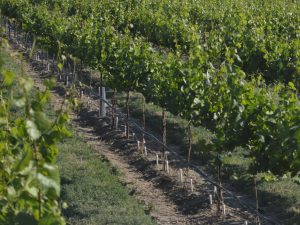
Table 1. Experimental treatments applied in ‘Cabernet Sauvignon’ vineyards from 2016 to 2018. DRZ: direct root-zone irrigation; SD: surface drip irrigation; ETc: crop evapotranspiration.

Effects of irrigation rate and water delivery depth through DRZ on grape production, water use efficiency, and root distribution were investigated in 2016. We also evaluated the efficiency of DRZ on grape yield and water use efficiency by comparing it to SD in 2017 and 2018. Two irrigation systems are shown in Fig. 2. Grapes were harvested by hands in each year, and fruit yield from each vine was weighed on site (Fig. 3). Samples of grapes from each treatment plot were packaged and delivered immediately to a nearby commercial laboratory (ETS Laboratories, Walla Walla, WA) for quality analyses. Water use efficiency at crop level (WUEy) was calculated based on the equation: WUEy = Grape yield per ha / total water use amount in kg ha-1 mm-1 (irrigation plus rainfall from bud break to harvest). The minirhizotron system (CI-600 in-situ root imager, CID Bio-science, Inc., WA), which is designed to slide down inside a transparent tube and to take root pictures belowground, was used for observations of root growth and distribution (Fig. 4).
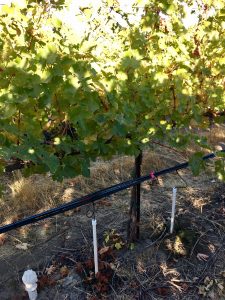
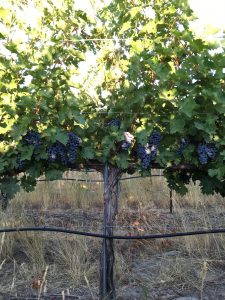
Figure 2. Direct root-zone irrigation system (left) and surface drip irrigation system (right).
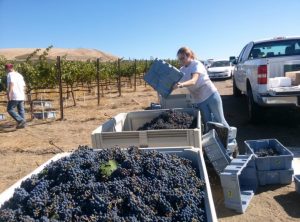
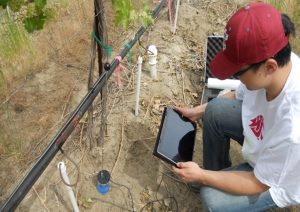
2) Greenhouse research
A greenhouse research was conducted to compare the biomass partitioning and abscisic acid (ABA) biosynthetic and catabolic gene expressions in grapevines under water deficit (Fig. 5). Daily temperature and illumination periods were automatically controlled with 75°F/16h at daytime and 55°F/8h at night. Experimental seedlings of ‘Cabernet Sauvignon’ were donated by Inland Desert Nursery, Inc. (Benton City, WA). We randomly selected 24 seedlings with similar weight and height, and planted them in each of white pots (30 cm wide × 120 cm deep). A minirhizotron tube (142 cm long) was inserted into each pot for root observation. We randomly assigned the watering rate (four levels: full, high, moderate, or low) to each vine, and watered them with an approximately weekly interval. Leaves were sampled periodically for analyses of ABA-related gene expression.
Another pot experiment was focusing on biomass partitioning under different water stress levels. Grapevine seedlings were randomly selected and planted in small round pots (25 cm deep × 30 cm wide). It was a completely randomized design with twenty replicates for each watering treatment (well-watered, moderate water stress, and severe water stress). We randomly harvested four seedlings from each treatment every month from June to September to observe dynamics of biomass allocation. All samples were oven dried at 60 °C for 48-60 hours, and biomass in different parts (root, shoot, leaf) of each vine were measured. Seedling heights were measured before harvest.
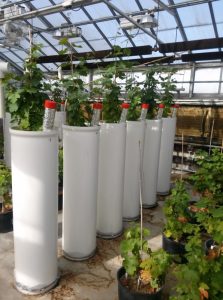
Here we report the major research findings on ‘Cabernet Sauvignon’ grapevines to illustrate the efficiency of DRZ on water use efficiency, grape production, and grapevine growth based on project objectives. Major results from research on ‘Chardonnay’ grapevines are reported through the field day handout.
Objective 1: Evaluate efficiency of our subsurface micro-irrigation strategy on water conservation
1) Irrigation rate, not the water delivery depth, influences grape yield and crop water use efficiency
Irrigation rate significantly influenced yield per vine in 2016 (Fig. 6). Decreasing yield was observed with the decrease in irrigation rate. No significant difference in yield was found between different delivery depths, and no interaction effect was found between irrigation rate and delivery depth on grape yield.
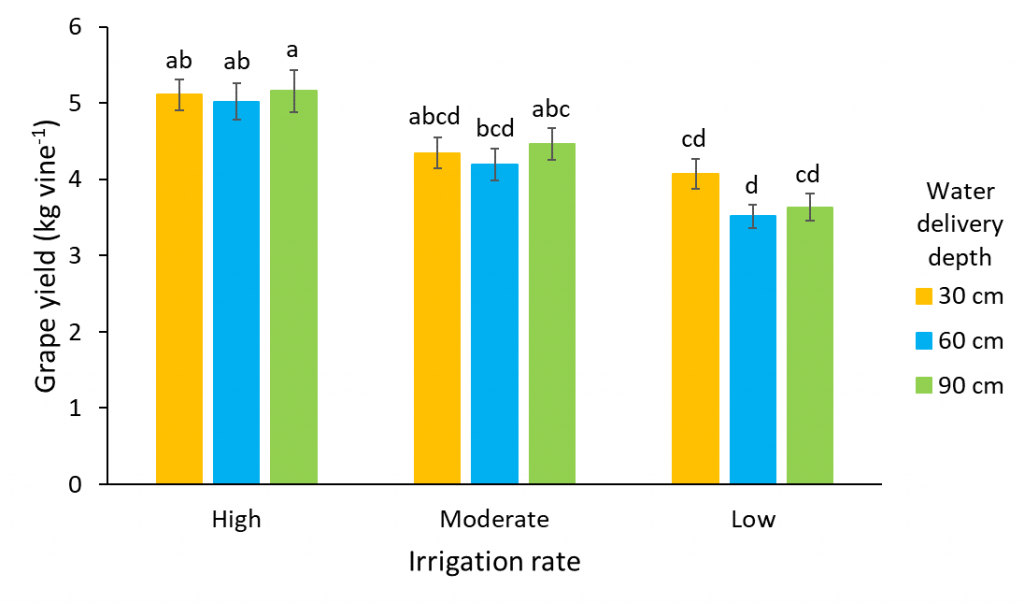
WUEy was generally higher at the lowest irrigation rate, and decreased with an increase in irrigation rate (Fig. 7). Difference in WUEy between high and low irrigation rates was significant. No difference was found between water delivery depths. No interaction effect between irrigation rate and water delivery depth was found.
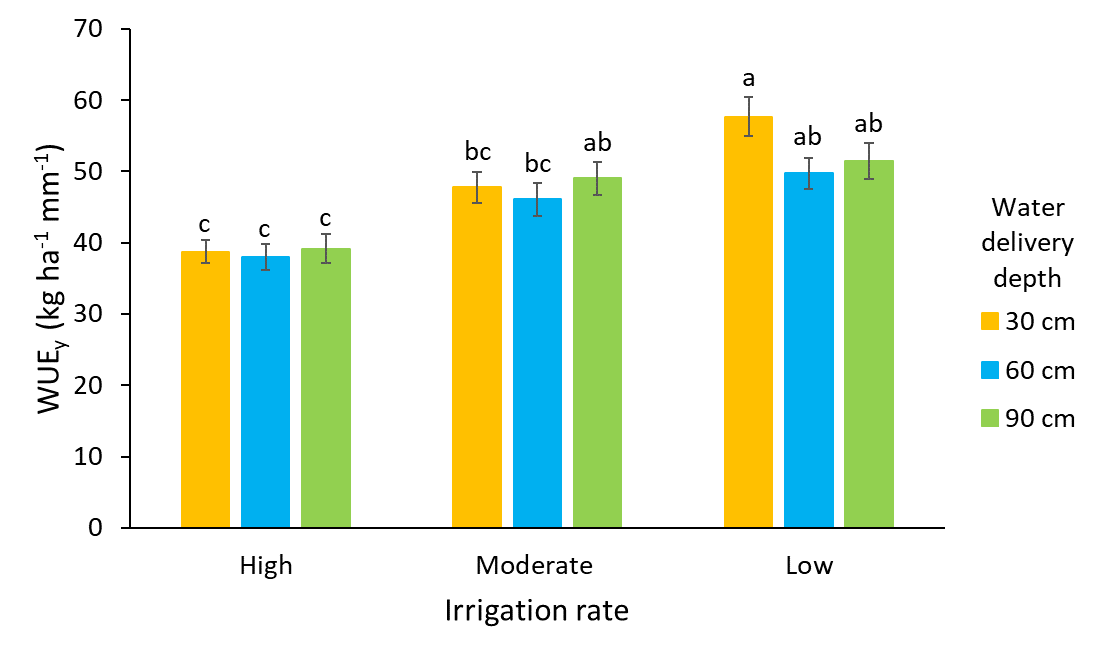
2) DRZ outperforms SD on grape production and crop water use efficiency
Grape yields under different irrigation rates and methods were compared at harvest in 2017 and 2018 (Fig. 8). Within each year, no significant differences of yield were found between different irrigation rates under the same irrigation method, and no significant differences were found between two irrigation methods under the same irrigation rate. Although no significant decreases of yield were found with the reduction of irrigation water amount based on our treatments, mean values of grape yield were higher with the DRZ compared to SD. No significant differences in grape yield were found between high and low irrigation rates with each of the two irrigation methods; however, grape yield at the high irrigation rate through DRZ was significantly higher than grape yield at the low irrigation rate by SD in both years. No interaction effect was found between irrigation rate and method on grape yield.
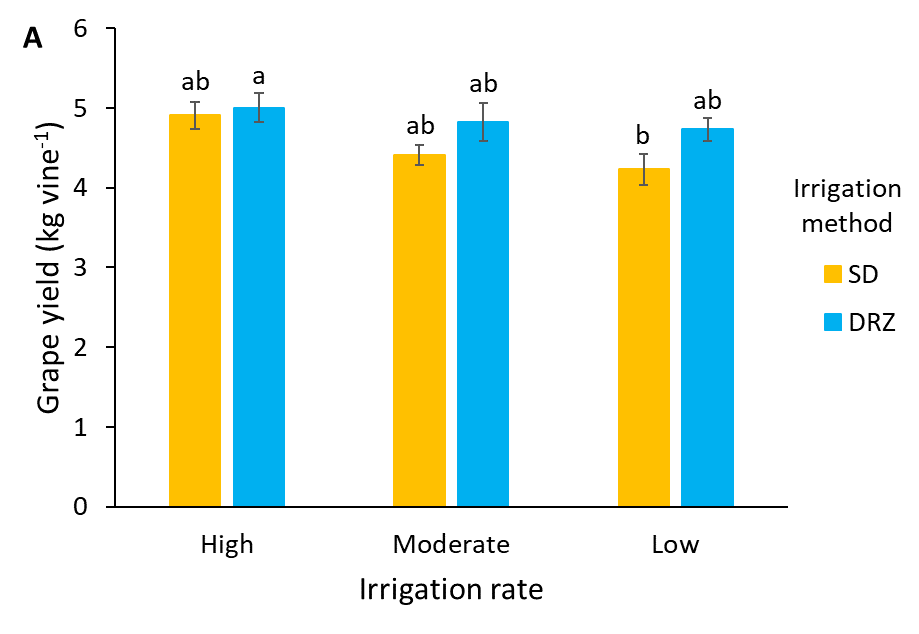
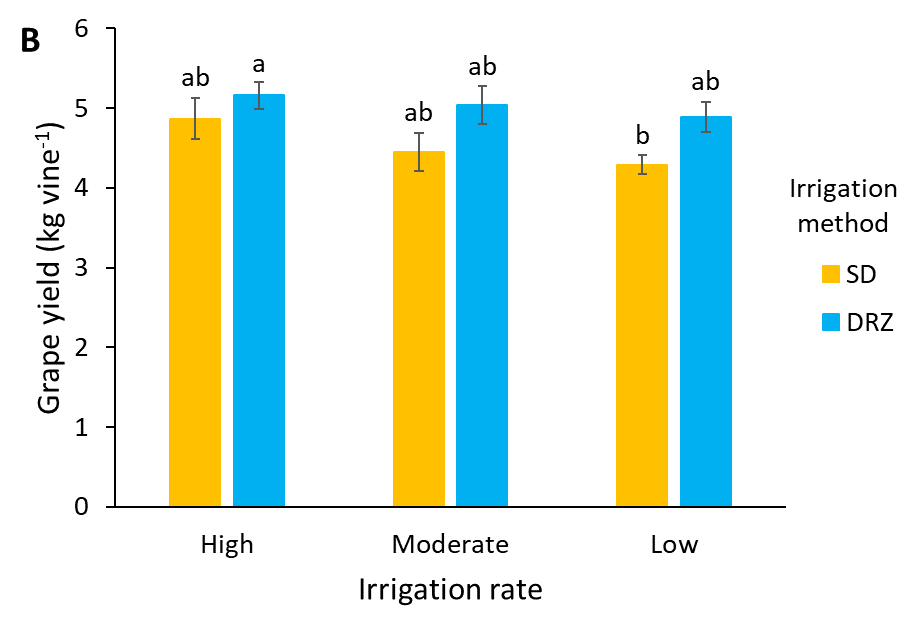
Figure 8. Grape yields (kg vine-1) at harvest under different irrigation rates and methods in A) 2017 and B) 2018. SD: surface drip irrigation; DRZ: direct root-zone irrigation. Within each year, lowercase and different letters indicate statistically significant differences at p < 0.05 between treatments based on Tukey’s HSD test. Error bars represent standard error.
WUEy was affected both by irrigation rate and method across the two years of study (Fig. 9). WUEy generally decreased with an increase in irrigation rate, and grapevines under the lowest irrigation rate had the highest WUEy for both irrigation methods. No significant differences were found between high and moderate irrigation rates for grapevines irrigated by SD; however, grapevines irrigated through DRZ had significantly higher WUEy at moderate irrigation rate than at high irrigation rate in both years. Although mean values of WUEy for grapevines irrigated by DRZ were always higher than grapevines irrigated by SD for all irrigation rates, a statistical difference was only found at low irrigation rate in 2018. No interaction effect between irrigation rate and method was found during this study.
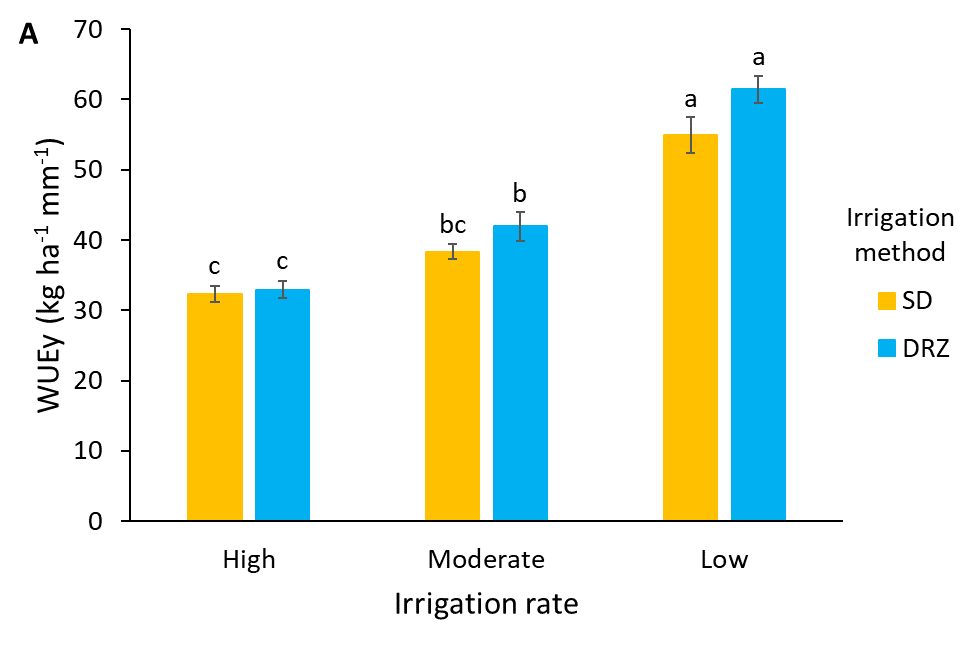
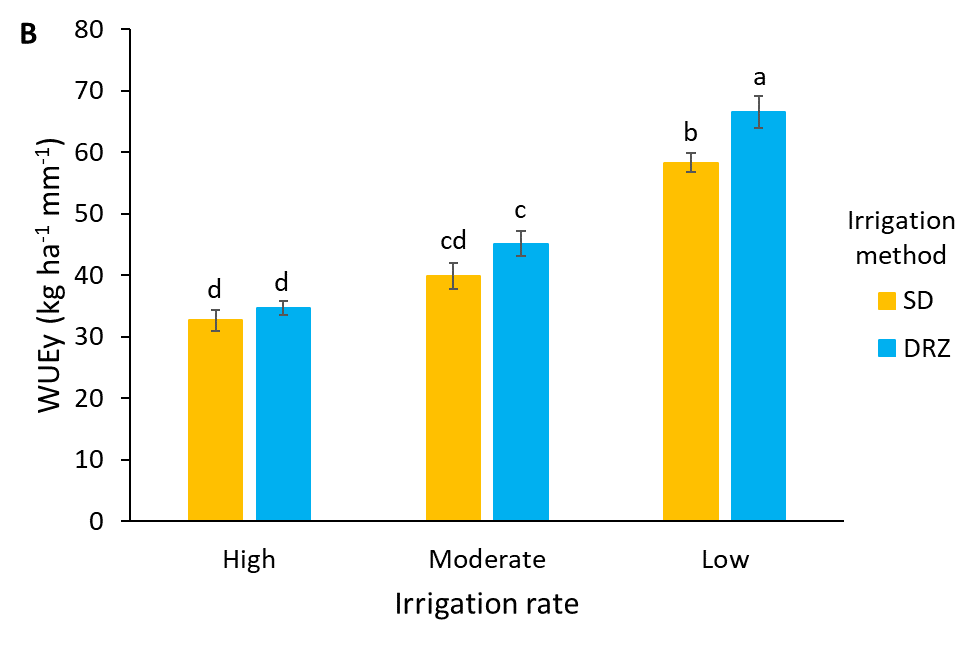
Figure 9. Water use efficiency at crop level WUEy (kg ha-1 mm-1) under different irrigation rates and methods in A) 2017 and B) 2018. SD: surface drip irrigation; DRZ: direct root-zone irrigation. Within each year, lowercase and different letters indicate statistically significant differences at p < 0.05 between treatments based on Tukey’s HSD test. Error bars represent standard error.
Objective 2: Measure the impact of our new subsurface micro-irrigation strategy on grapevine growth and fruit quality
1) Grape quality is largely influenced by irrigation rate
Since no significant effect of subsurface delivery depth and no interaction effect was found on grape yield, we specifically investigated the influence of irrigation rate using the DRZ system on four grape qualitative parameters in 2016 (Fig. 10). Three grape quality parameters were significantly influenced by irrigation rate. Titratable acidity decreased with decreased irrigation rate. In contrast, the highest values of total soluble solids (TSS) and total anthocyanins were observed at low irrigation rate. No significant difference in tannin content was observed across three irrigation rates.
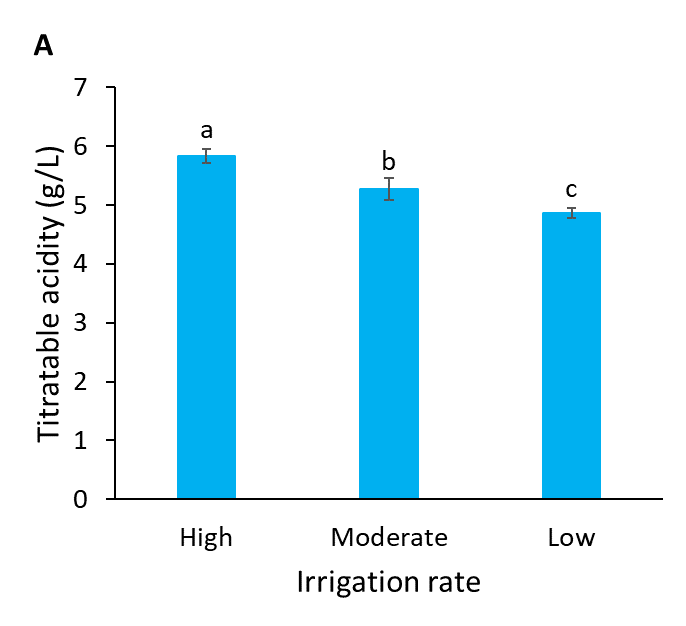
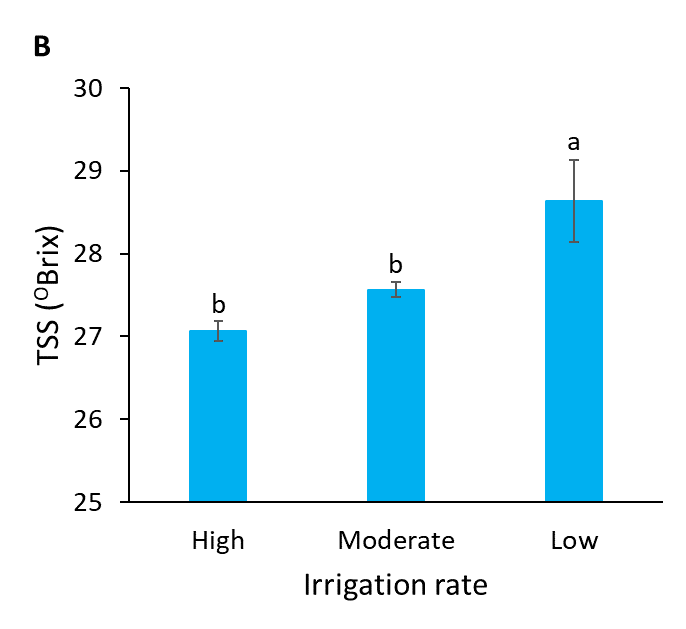
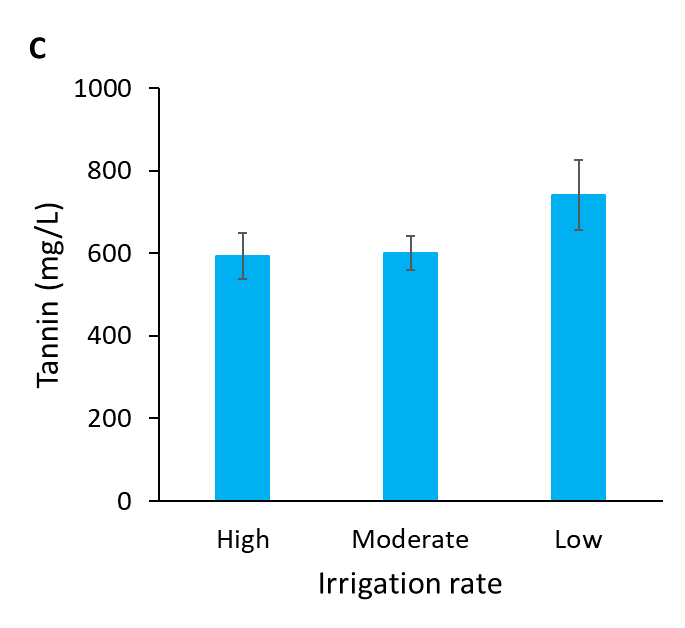
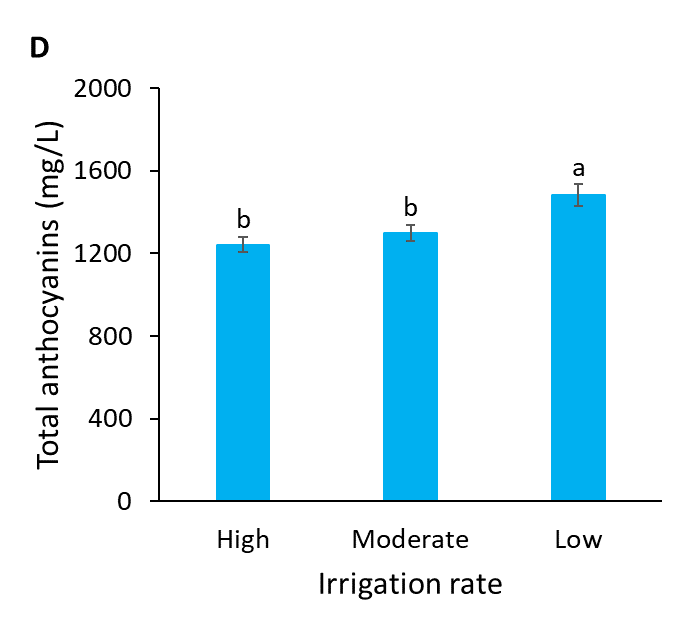
Figure 10. Grape quality at harvest in ‘Cabernet Sauvignon’ grapevines in 2016 under different irrigation rates through DRZ: A) titratable acidity (g L-1), B) total soluble solids (TSS) (oBrix), C) tannin (mg L-1), and D) total anthocyanins (mg L-1). Lowercase and different letters indicate statistically significant differences at p < 0.05 between treatments based on Fisher’s LSD test. Error bars represent standard error.
2) Root counts and lengths decrease with increased water delivery depth
The effects of water delivery depths on root distribution in the top 60 cm of the soil profile were investigated using a minirhizotron system. Water delivery depth significantly influenced root count and total root length within this portion of the soil profile, with the lowest root counts and total lengths in this zone occurring when water was delivered at the 90 cm delivery depth (Fig. 11). No significant difference on total root counts or total root lengths was found when water was delivered at either the 30 cm or 60 cm delivery depth.
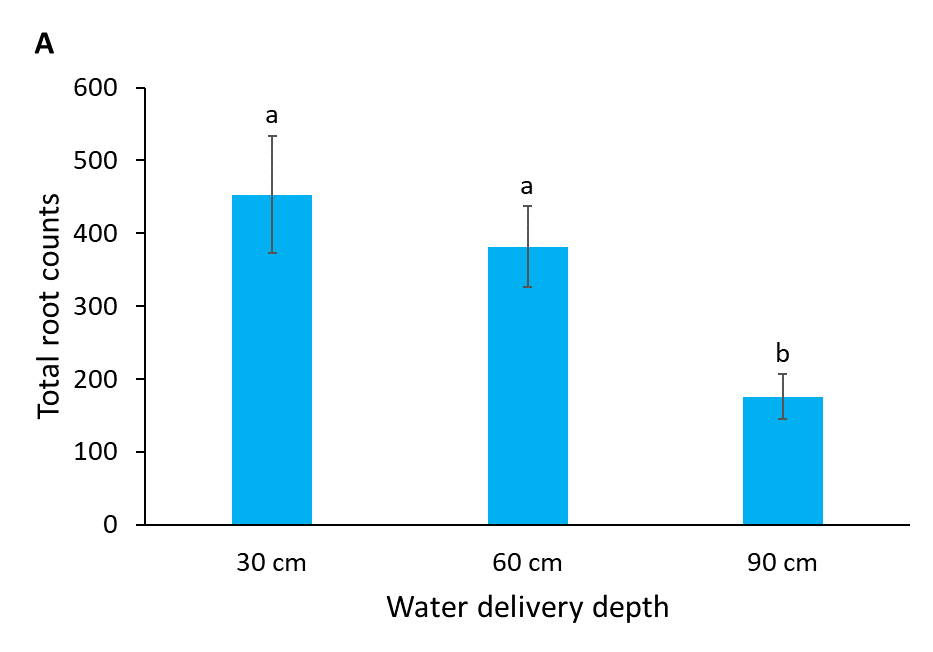
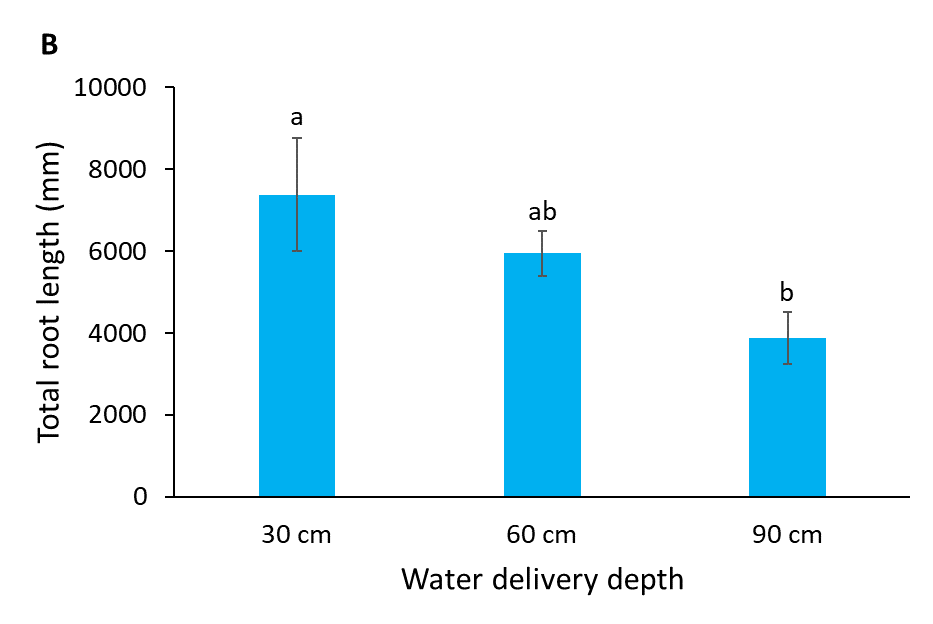
Figure 11. A) total root counts and B) total root lengths (mm) in the top 60 cm of the soil profile at veraison under different water delivery depths in 2016. Lowercase and different letters indicate statistically significant differences at p < 0.05 between treatments based on Fisher’s LSD test. Error bars represent standard error.
3) Moderate water stress encourages grapevines to invest more resource in root development
Compared to grapevines under severe water stress, accumulations of the total biomass and root biomass were faster during the late growing stage of grapevines under no and moderate water stress (Fig. 12 A and C). Moderate water stress resulted in decrease of aboveground biomass (Fig. 12 D); however, Changes of root biomass were similar in grapevines under well-watered status and moderate water stress during the course of our study (Fig. 12 C). Aboveground height of grapevines decreased with increased water stress (Fig. 12 B). Grapevines under severe water stress had the lowest height and biomass accumulation.
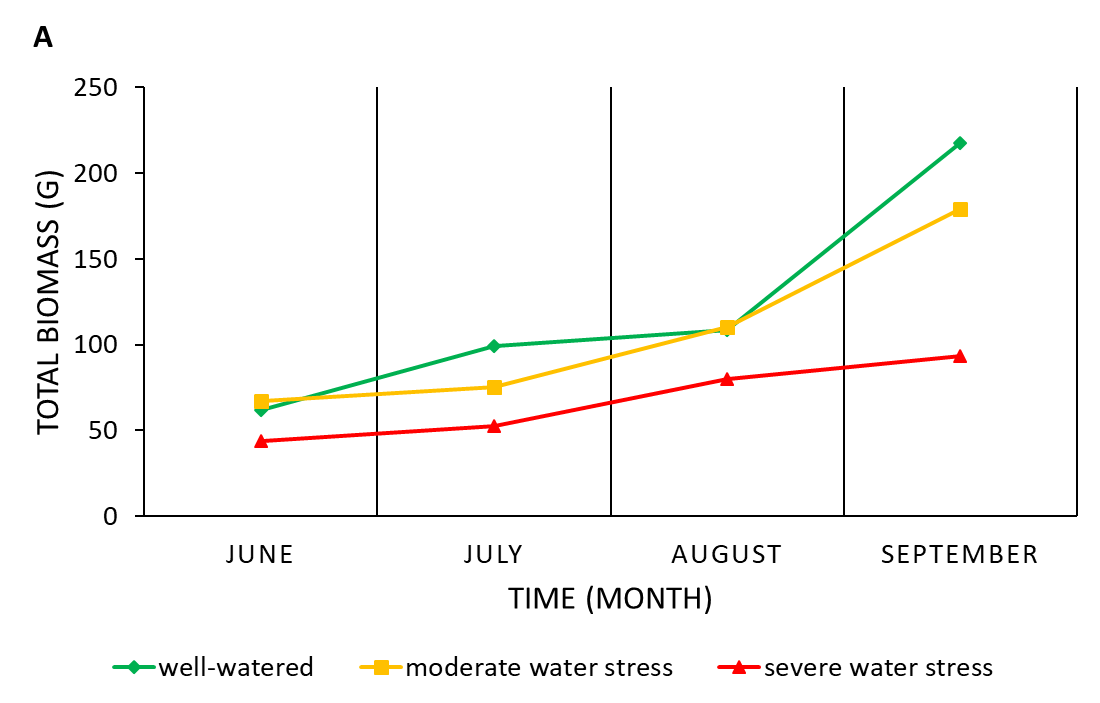
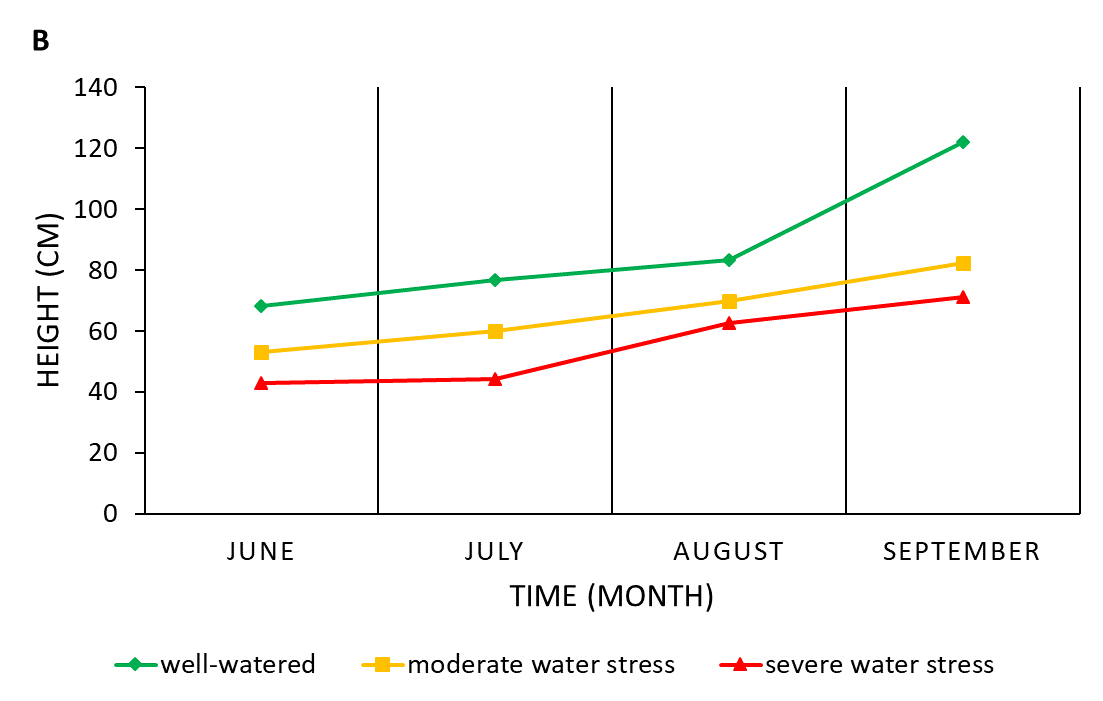
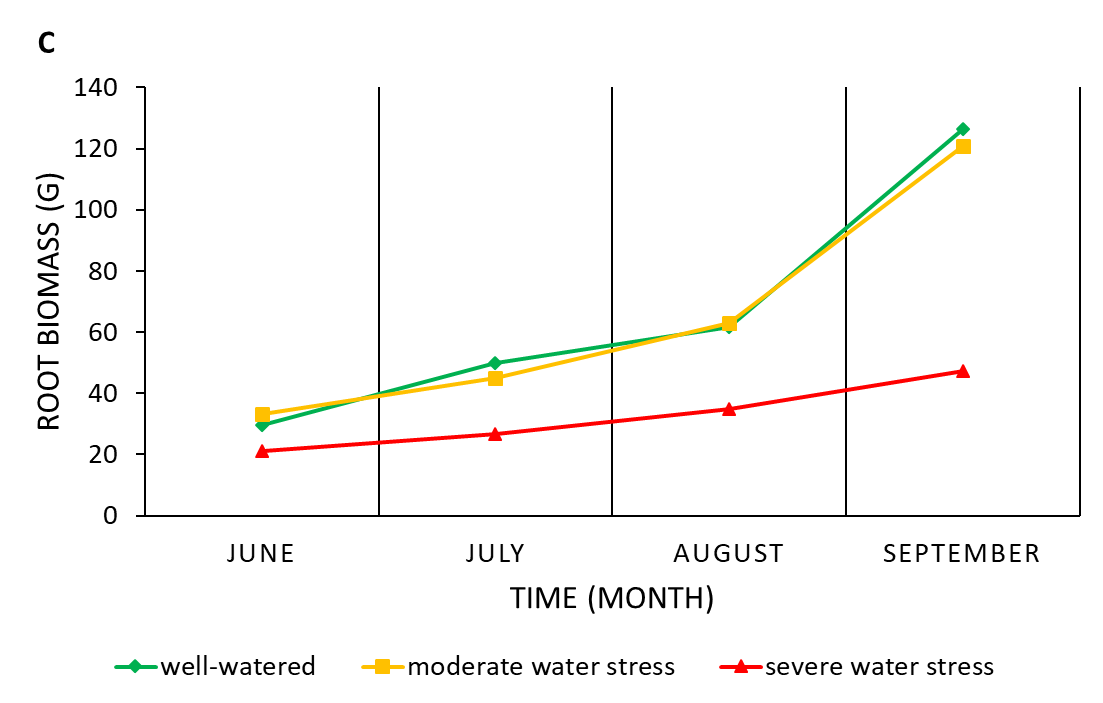
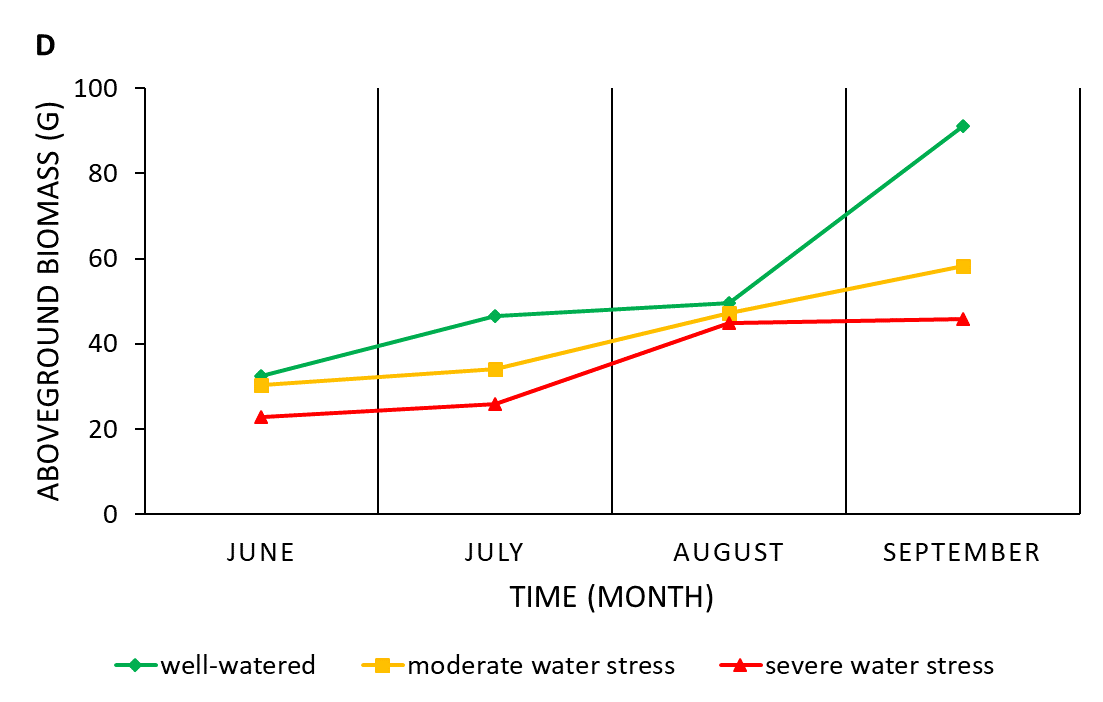
Figure 12. Dynamics of biomass partitioning in grapevines under different water stress levels. A) total biomass (g vine-1), B) height (cm vine-1), C) root biomass (g vine-1), and D) aboveground biomass including shoots and leaves (g vine-1).
4) ABA biosynthetic and catabolic genes are highly expressed under water stress, which could be used as indicators of stress status in grapevine by correlating them with other physiological parameters.
We compared four ABA-related gene expressions under well-watered and water stress conditions. ABA biosynthetic gene Vvnced2 and catabolic genes VvABA8’OH-1 and VvABA8’OH-2 were highly expressed under water stress condition (Fig. 13).
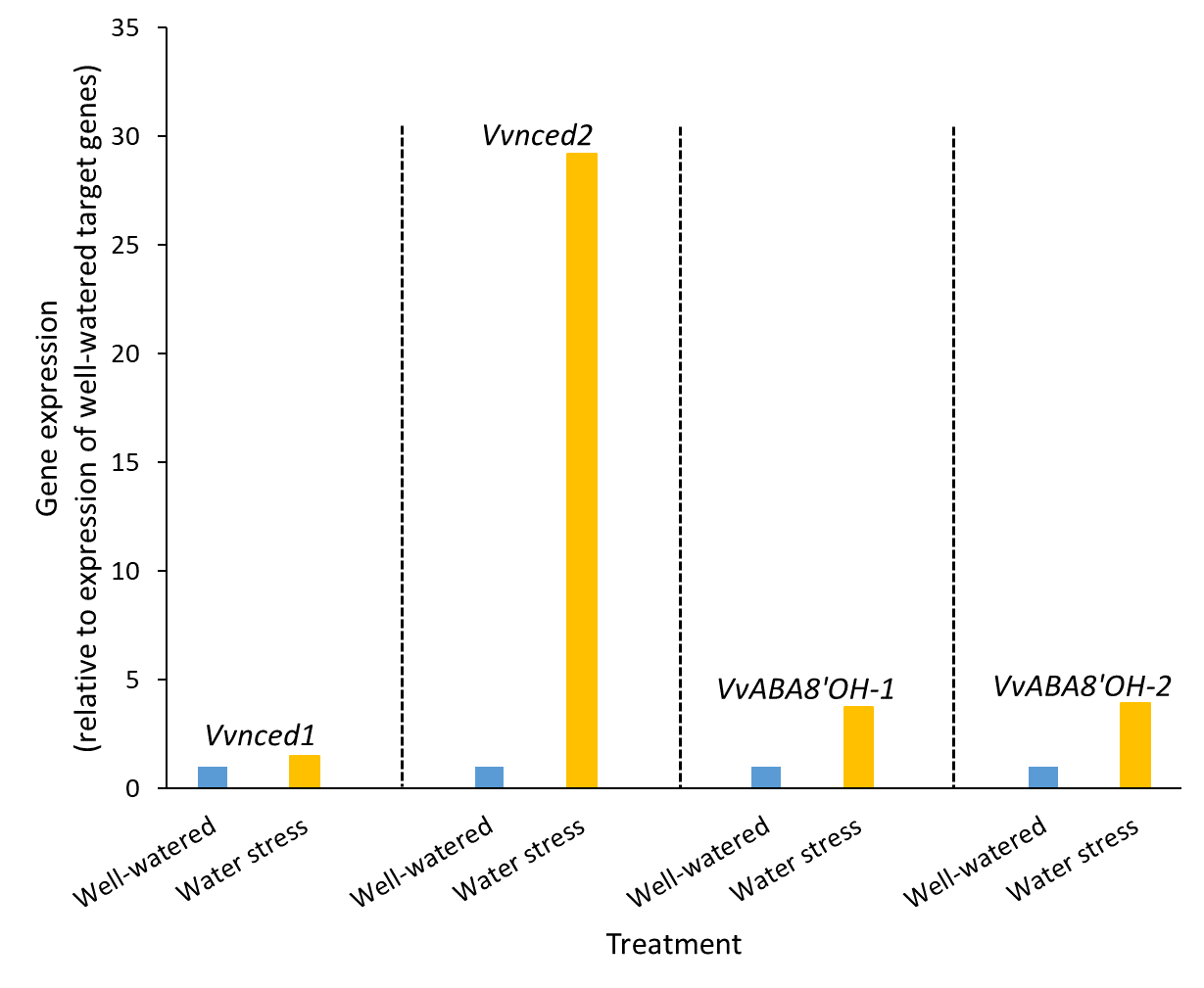
Based on our research findings, we conclude that DRZ provides a potential to improve the efficiency of water use in arid environments that heavily rely on supplemental irrigation. A decrease in the irrigation rate reduced grape yield per single grapevine; however, it sustained or enhanced grape quality and improved water use efficiency for yield. Subsurface delivery depth had no significant effect on grape yield and water use efficiency for yield, which has the potential to provide growers a flexible way to modify delivery depths based on specific environmental conditions and management goals. However, delivery depth did influence root development, which provides a possibility to promote root growth in deeper soil to enhance drought tolerance in grapevine. Future studies need to be conducted to evaluate the long-term effects of DRZ on grape production and grapevine physiology in different soil types under different climates to better define the optimum conditions for the successful utilization of DRZ strategy.
Research Outcomes
Education and Outreach
Participation Summary:
On-farm demonstration:
We had an on-farm demonstration combined with Washington viticulture field day which was held by WSU Viticulture and Enology Program (August 12, 2016). A presentation about deep irrigation was given by our project team, which discussed research on subsurface irrigation strategy and grapevine response. Besides, we showed our irrigation equipment (electronic controllers, water delivery tubes, etc.) to growers and students, and demonstrated how we regulated this subsurface micro-irrigation system in vineyard (Fig. 14).
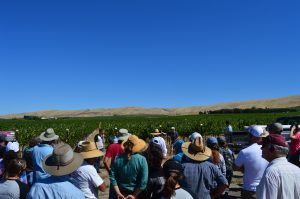
Consultations:
A hazelnut grower and a grape grower from Oregon state consulted with our lab and developed grant proposals testing the DRZ system in their commercial orchards.
Press releases:
1) Introducing direct root-zone deficit irrigation to conserve water and enhance grape quality in the Pacific Northwest. 2018. Crops & Soils Magazine. October 4. https://dl.sciencesocieties.org/publications/cns/abstracts/51/5/34/. This extension article introduces our research project on water management in vineyards and explains how the novel subsurface micro-irrigation strategy influences grape production and vineyard management.
2) Making a difference: teaching sustainability. 2018. Our Farms, Our Future Podcasts. September 7: https://www.sare.org/Newsroom/Press-Releases/Our-Farms-Our-Future-Podcast-Making-a-Difference-Teaching-Sustainability/. This podcast shares techniques for teaching undergraduates about emerging sustainable practices and their critical environmental impact.
3) Student’s intellect, drive result in scholarships and grants. 2018. WSU Insider. June 22: https://news.wsu.edu/2018/06/22/atypical-driven-student-wins-scholarship/. This article written by Scott Weybright was one of four stories featured on the CAHNRS home page describing the achievements of Xiaochi Ma on education and research of sustainable viticulture.
4) WAVE Minute: Irrigation Developments. 2017. Washington Ag Network. August 3: http://www.washingtonagnetwork.com/2017/08/03/wave-minute-irrigation-developments/. This radio news recorded by Glenn Vaagen discusses our latest irrigation technology and research taking place at WSU.
5) Study pushes limits of deficit irrigation. 2017. Good Fruit Grower. July 24: http://www.goodfruit.com/study-pushes-limits-of-deficit-irrigation-trials/. This article written by Kate Prengaman describes our research in Red Mountain AVA.
6) Deeper irrigation method showing promise for vineyards. 2016. Growing Produce. August 23: http://www.growingproduce.com/fruits/grapes/deeper-irrigation-method-showing-promise-for-vineyards/. This article written by Brian Wallheimer shows promise of our irrigation system in vineyards and interests from growers.
7) Conserving water through subsurface delivery and precision irrigation scheduling. 2017. Washington and Oregon Trip Report 2017 (pp. 45-46). May 2: https://www.mastersofwine.org/en/document-summary/document-summary.cfm/docid/B65D687D-B29B-48B9-BB649DB1FACE803D/. This report written by The Institute of Masters of Wine summarized our research concept and findings on the novel subsurface micro-irrigation system.
Talks and presentations:
1) Pete Jacoby and Xiaochi Ma. 2018. Oral with full-length technical article: Direct root-zone drip irrigation to enhance precision deficit irrigation. Irrigation Show & Education Conference. December 3-7. Long Beach, CA.
2) Xiaochi Ma, Andrei Smertenko, Markus Keller, Pete Jacoby, Karen Sanguinet. 2018. Oral: Enhancing crop production and water conservation through direct root-zone irrigation strategy. American Society of Agronomy and Crop Science Society of America Annual Meeting. November 4-7. Baltimore, MD.
3) Xiaochi Ma, Karen Sanguinet, Andrei Smertenko, Pete Jacoby. 2018. Oral and poster: Performance of Cabernet Sauvignon under direct root-zone deficit irrigation. 69th American Society for Enology and Viticulture National Conference. June 18-21. Monterey, CA.
4) Pete Jacoby and Xiaochi Ma. 2018. Poster: Conserving water while increasing efficiency of grape production through direct root-zone deficit irrigation. 69th American Society for Enology and Viticulture National Conference. June 18-21. Monterey, CA.
5) Gillian Hawkins, Pete Jacoby, Xiaochi Ma. 2018. Poster: Cabernet Sauvignon berry quality from vines irrigated through direct root-zone irrigation. 69th American Society for Enology and Viticulture National Conference. June 18-21. Monterey, CA.
6) Xiaochi Ma, Karen Sanguinet, Pete Jacoby. 2018. Invited oral and poster: Effects of Subsurface Micro-irrigation on Water Use Efficiency and Grapevine Growth. Our Farms, Our Future National Conference (SARE, USDA). April. 3-5. St. Louis, MO.
7) Gillian Hawkins, Pete Jacoby, Xiaochi Ma. 2018. Poster: Cabernet Sauvignon berry quality from vines irrigated through direct root-zone irrigation. Showcase for Undergraduate Research and Creative Activities (WSU). April 2. Pullman, WA.
8) Alexis Torp, Pete Jacoby, Xiaochi Ma. 2018. Poster: Deficit irrigation in grapevines. Showcase for Undergraduate Research and Creative Activities (WSU). April 2. Pullman, WA.
9) Xiaochi Ma, Pete Jacoby, Karen Sanguinet. 2018. Poster: Influences of direct root-zone deficit irrigation on wine grape production, grapevine growth, and root distribution in Pacific Northwest. GPSA Research Exposition (WSU). March 29. Pullman, WA.
10) Xiaochi Ma, Pete Jacoby, Karen Sanguinet. 2018. Poster: Comparing effects of different irrigation rates and depths on wine grape production, grapevine growth, and root development through direct root-zone irrigation strategy. Washington Winegrowers Convention & Trade Show. February 5-7. Kennewick, WA.
11) Gillian Hawkins, Pete Jacoby, Xiaochi Ma. 2018. Poster: Cabernet Sauvignon berry quality from vines irrigated through direct root-zone irrigation. Washington Winegrowers Convention & Trade Show. February 5-7. Kennewick, WA. (3rd place award – undergraduate poster category).
12) Xiaochi Ma, Pete Jacoby, Karen Sanguinet. 2017. Poster: Influences of direct root-zone deficit irrigation on wine grape production, grapevine growth, and root distribution in Pacific Northwest. American Society of Agronomy, Crop Science Society of America, and Soil Science Society of America (ASA, CSSA, SSSA) 2017 Annual Meeting. October 22-25. Tampa, FL. (1st place award – graduate presentation category).
13) Xiaochi Ma, Pete Jacoby, Alexis Torp, Gillian Hawkins, Lindsey Mongan. 2017. Poster: Effects of root-zone deficit irrigation on crop growth, fruit yield, and agroecosystem stability: using the wine grapevine Cabernet Sauvignon as a model. Ecological Society of America 102nd Annual Meeting. August 6-11. Portland, OR. https://eco.confex.com/eco/2017/webprogram/Paper66329.html.
14) Xiaochi Ma, Jeremy Thompson, Pete Jacoby. 2017. Poster: A strategy to enhance water conservation and sustain grape production in Pacific Northwest. Center for Precision & Automated Agricultural System (CPAAS) Agricultural Technology Day. July 31. Prosser, WA. 2017-CPAAS-Poster-Xiaochi-Ma
We gave a poster presentation, and had a good networking with local growers, agricultural industry professionals, crop consultants and researchers during this event, which was hosted by WSU CAHNRS’s Center for Precision & Automated Agricultural Systems (Fig. 15).
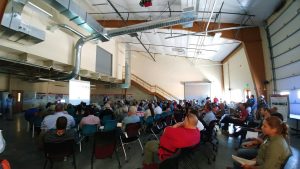
15) Pete Jacoby, Xiaochi Ma, Jeremy Thompson. 2017. Poster: Maintaining vineyard production with season-long deficit irrigation. 68th American Society of Enology and Viticulture National Meeting. June 26-29. Bellevue, WA.
16) Pete Jacoby and Xiaochi Ma. 2017. Oral: Novel irrigation delivery system. Washington Advancements in viticulture & Enology (WAVE), Washington Wine Industry’s Research Program, International Masters of Wine WA/OR Tour. May 2. Richland, WA.
Dr. Pete Jacoby gave this talk about our advance irrigation system and research conducted in vineyards to more than 50 Masters of Wine (MW), the people from different countries who have demonstrated thorough knowledge of all aspects of wine and ability to communicate clearly (Fig. 16).
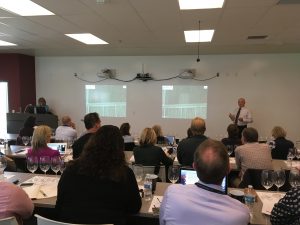
17) Pete Jacoby, Xiaochi Ma, Jeremy Thompson. 2016. Oral with full length technical article: Effects of root-zone micro-irrigation on Cabernet Sauvignon. Proceedings: Technical Education Conference on Use of Micro-irrigation in Agricultural Cropping Systems, Irrigation Show & Education Conference. December 5-9. Las Vegas, NV.
18) Xiaochi Ma, Pete Jacoby, Jeremy Thompson. 2016. Poster: Assessing impacts of direct root-zone irrigation on grapevine physiology. American Society of Agronomy, Crop Science Society of America, and Soil Science Society of America (ASA, CSSA, SSSA) 2016 Annual Meeting. November 7-11. Phoenix, AZ. (3rd place award – graduate poster category). https://scisoc.confex.com/crops/2016am/webprogram/Paper100398.html.
*Interaction with growers during meetings where posters were presented: Poster presentations, especially those featured at events designed for growers, are valuable means of engaging growers and discussing points of interest to them. This process allows the researcher to sense the level of interest by growers related to the featured research issues. We have seen growers expressing interest in both water conservation and the potential of DRZ to improve the effectiveness of using regulated deficit irrigation to improve fruit quality for use in production of high quality premium wines.
Educational tool – Web page:
We built a stand-alone web page for this project in early 2017 that is linked with Jacoby’s laboratory page at Washington State University (https://labs.wsu.edu/jacoby/). This page provides general information about our project and announcements we have for our education & outreach events. We also show our latest press releases and scientific publications that are related with this project on our website.
Field day handout:
Enhancing wine grape production through subsurface direct root-zone irrigation. 2017. For: field day in Hogue Ranches ‘Chardonnay’ vineyards. June 15. Prosser, WA. https://projects.sare.org/wp-content/uploads/Field-day-handout-June-15-2017.pdf
Undergraduate research training:
We mentored and worked closely with four undergraduate students on their wine grape and water management research projects based on this grant, and helped them develop research posters, which they presented at professional meetings and research showcase.